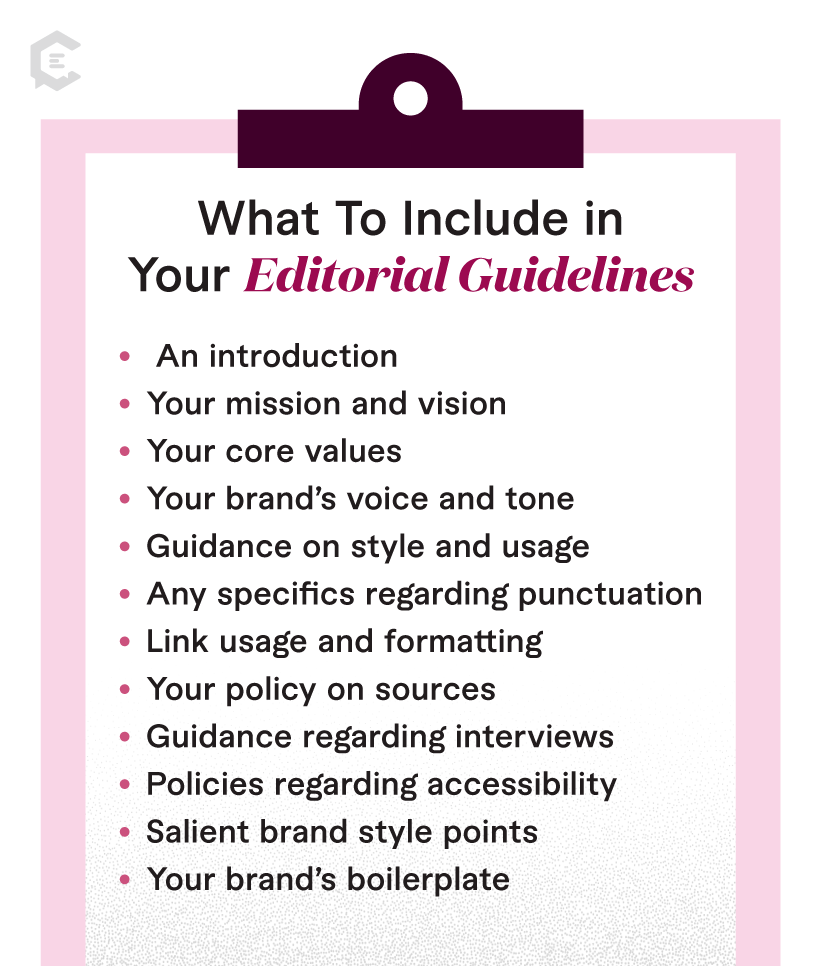What are editorial guidelines?
Editorial guidelines are a codified framework you share with anyone who creates written content for your brand. These guidelines ensure that your content remains consistent and within your brand voice, no matter who writes for you.
Your editorial guidelines keep your written communication feeling like it’s coming directly from your brand, whether you’re creating it in-house or outsourcing it to a team of freelancers.
And while they’re called “guidelines,” they’re not meant to be taken lightly. These are the hard-and-fast rules your content creators will follow until otherwise notified.
Why are editorial guidelines important?
As your team grows, you’ll have plenty of “cooks in the kitchen,” as it were, when it comes to the content you put out into the world. The people you hire will have their own unique styles and capabilities for creating content, but if you want to maintain your customers’ trust and loyalty, your brand must remain consistent.
And that means consistency in all areas, from every writer across all platforms. So, how do you keep your content on-brand when multiple people create it?
By putting together editorial guidelines for all of your content creators.
How do you create editorial guidelines?
If you’ve already done the work to establish your brand identity, the good news is that much of the heavy lifting is complete. Then, you’ll want to choose a style guide (like AP Style or the Chicago Manual of Style) as your foundation and add any modifications that apply to your brand.
From there, you can follow these steps:
- Describe your target audience/personas. This is the heavy lifting we mentioned earlier. Pull this language from the brand work you’ve already done.
- Describe your brand voice. Again, this is largely done if you’ve established your brand identity. But to give a voice to your style guide, communicate specific traits that your brand voice should embody. Give lots of detail! Imagine your brand voice as a cartoon character. What would it sound like?
- Establish your brand messaging. How will your written communication handle industry jargon? Be clear with how writers should address industry-specific terms, product names, trademarks, or catchphrases associated with your company.
- Draft social media guidelines. How will your brand be represented there, and on which platforms? What kinds of imagery will you use? What will you post about? What will you not post about?
- Cover all your bases. Consider how your brand will address issues of equality, inclusion, etc. Be clear on your expectations about how you will handle potentially sensitive topics in your written communication.
What should you include in your editorial guidelines?
Glad you asked! Your editorial guidelines should be as specific as possible so that there’s very little room for interpretation among various team members. Here’s our own checklist:
What to include in your Editorial Guidelines
Follow this checklist:
- An introduction
- Your mission and vision
- Your core values
- Your brand’s voice and tone
- Guidance on style and usage
- Any specifics regarding punctuation
- Link usage and formatting
- Your policy on sources
- Guidance regarding interviews
- Policies regarding accessibility
- Salient brand style points
- Your brand’s boilerplate
And don’t forget to use your editorial guidelines when creating your editorial guidelines! This document should feel as on-brand as any other piece of written communication you create. Lead by example!
When to Use Editorial Guidelines
Simply put, your editorial guidelines should infuse every piece of written content your brand puts out into the world. Your editorial guidelines are how you communicate your brand through the written and spoken word. They are a crucial component of your overall brand identity!
Any time you and your team write content, you should use your editorial guidelines.
Editorial Guidelines vs. Brand Guidelines
Editorial guidelines and brand guidelines both fall under the umbrella of your brand identity. “Brand identity” and “brand guidelines” can sometimes be used interchangeably; however, brand guidelines typically refer to both visual and verbal guidelines around your brand (like logo, signature colors, typeface, etc.).
Editorial guidelines encompass only the guidelines that apply to your written content.
Editorial Guidelines Are Essential
At ClearVoice, better content is what we do. And creating great content starts with a holistic understanding of your brand. When you partner with ClearVoice as your managed content solution, we’ll work with you to establish clear editorial guidelines – if you don’t already have them – so that you can trust that the content we deliver is always on-brand and publish-ready, just as if you’d created it yourself!
Ready to get started? Talk to a content specialist today!







